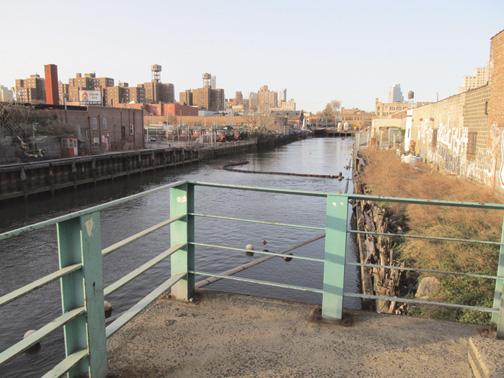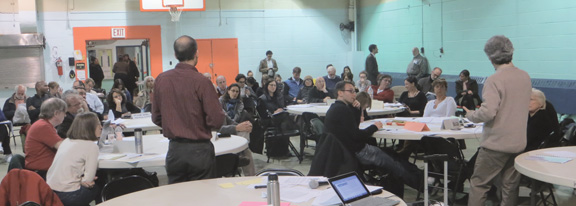Last December the EPA published their proposed plan for remediation of the Gowanus Canal. A public comment period lasted through April 27th. For the next few months the EPA team will evaluate the comments and by the end of the summer, they will issue a formal response. The EPA has received approximately 1,400 comments. This does not count names signed to petitions. All of the points raised by the commenters will be collated and responded to. The questions and the responses will be posted on the EPA website.

Red Hook will be looking specifically at the portions of the December proposal that deal with the disposition of the dredged material as well as the dewatering process. The EPA has proposed to ship all the sludge from the upper two thirds of the canal to an offsite disposal facility. An option to create landfill from the less contaminated lower one third – the five feet of mud under the canal south of Hamilton Avenue – was subject to public approval. This is the infamous Confined Disposal Facility (CDF), so opposed by local groups such as No-Toxic Red Hook as well as many residents of the Red Hook Houses. Red Hook will also be affected by the method the EPA chooses to remove water from the mud being dredged from the bottom of the canal.
Dewatering process up in air
This “dewatering” process has created some confusion, as most Red Hook citizens have only a layman’s knowledge of how the EPA handles contaminated waterways. An EPA report on removing sludge from the Great Lakes reveals three types of dewatering – passive, mechanical and active evaporative. Passive dewatering is described as “natural evaporation and drainage to remove moisture.” The document goes on to explain that this procedure usually takes place at CDFs.
Mechanical dewatering uses machines to squeeze out the water. This can be done on-site in a facility erected for this purpose, or – as Walter Mugberg mentioned at a recent public meeting – right on the barge as the material is lifted from the bottom. The December report is unclear on which process the EPA prefers. Mugberg himself suggested that they haven’t really figured out which option they will choose. It will be decided during the Remedial Design Stage – a three year period following the release of what they call “The Record of Decision (ROD).” This is the final plan that will appear in late summer and will also include the responses to the public comments.
For the three years following the ROD, implementation of the report will be planned by the Potentially Responsible Parties (PRPs). These are companies designated by the EPA as being responsible for the pollution. National Grid and the City of New York were deemed most responsible for the canal’s pollution. In addition, at least 29 other companies have been sent letters by the EPA indicating their designation as possible PRP’s. Under strict supervision by the EPA, the PRPs must choose and pay for the actual contracting of the work. Once everything is in place, the actual work begins. The EPA calls this period “Remedial Action,” which is expected to take another ten years.
The end of the public comment period is not the end of the EPA’s interest in what our community thinks. “My phone number is on our website,” said Natalie Loney, EPA’s Community Outreach Director. “I will always be available to the public.” The EPA may hold public meetings as issues come up. These issues are generally fine tuning. For example, a community might protest about noise created in the process. Then the cleaning might then just be done during the daytime.
Gowanus CAG gains stature
Another important tool that the EPA will use to stay in touch with the community is the Community Advisory Group (CAG). Many – but not all – Superfund sites have associated CAGs. These are groups initially set up with the help of the EPA, but are independent entities. EPA officials will often attend CAG meetings. A neutral facilitator paid for by the EPA leads the groups.

CAGs are composed of representatives from community organizations and interested individuals. An EPA document entitled “Guidance for Community Advisory Groups at Superfund Sites,” published in 1995, defines a CAG as “another mechanism designed to enhance community involvement in the Superfund process.”
The document continues, “CAG’s respond to a growing awareness within EPA and throughout the Federal government that particular populations who are at special risk from environmental threats – such as minority and low income populations – may have been overlooked in past efforts to encourage public participation. CAG’s are an effective mechanism to facilitate the participation of community members, particularly those from low-income and minority groups, in the decision making process at Superfund sites.”
The Gowanus CAG was formed in 2010. In addition to the at-large group, there are several committees. They include: Outreach, Archaeology, Real Estate and Water Quality & Technical. The executive meetings are held the fourth Tuesday of each month. The Gowanus CAG has no chairman or executive director, however there is the facilitator. The facilitator is responsible for directing the CAG, helping them fulfill their mission, leading executive and occasional committee meetings, helping to maintain contact with government, and keeping and publicizing the minutes. The contract for the CAG’s original facilitator, Jeff Edelstein, was not renewed. A new facilitator is on the verge of being chosen. According to a recent request for applicants, a facilitator is important because he or she would “likely be very successful in providing an avenue for community input into site decision-making.”
Current CAG members include representatives from CB6, Brooklyn Chamber of Commerce, Cobble Hill Association, Fifth Avenue Committee, Friends and Residents of Greater Gowanus (FROGG), Gowanus Canal Conservancy, Gowanus Houses Tenants Association, Proteus Gowanus, Riverkeeper, Sierra Club, and the Park Slope Civic Council. Out of a total of 29 community organizations, only 3 are from Red Hook – Red Hook East Tenant Association, Red Hook West Tenant Association and Red Hook Civic Association. Of these, only John McGettrick of the Civic Association regularly attend meetings.
In addition to representatives from community organizations, there are 23 “At-Large” members, representing themselves. Of these, eight are listed as being from Carroll Gardens, seven from Gowanus, four from Park Slope, one from Cobble Hill, and none from Red Hook. At the April 23rd monthly executive meeting, six more members were accepted. Two represent organizations: Reg Flowers, of the Good Shepard Services and Harriet Hughes, of the Warren Street Houses Tenant Association. Four new At-Large members were added – Phyllis Argento and Valerie Bell of Wyckoff Gardens, Rafael Kapoluna from Gowanus, and Trudy Milbern, of Carroll Gardens.
The Gowanus CAG operates under its own charter. Their mission statement includes the following goals: “Disseminating information to the community”; “Gathering information from the community and various sources”; “Discussing and assessing information”; “Adopting and voicing positions”;” Problem-solving issues relating to the clean-up and the community” and finally, “Providing input and guidance to EPA and others.”
As the only official public comment period has passed, the role of the CAG becomes more important as a means for the community to let the EPA know it’s thoughts on the clean-up.









2 Comments
The EPA Superfund Division Director is Walter Mugdan.
Now that the comment period on the Proposed Plan is over, the public has little or no official opportunity to convince EPA how to improve the cleanup.
Sometimes my brain doesn’t work exactly right. I wrote Mugberg from memory. My apologies. But my feeling is that the EPA will still be listening to the community. They say it will be just for fine tuning, but I imagine that they will also be responsive to a huge outcry, if there is reason for there to be one. We’ll see.